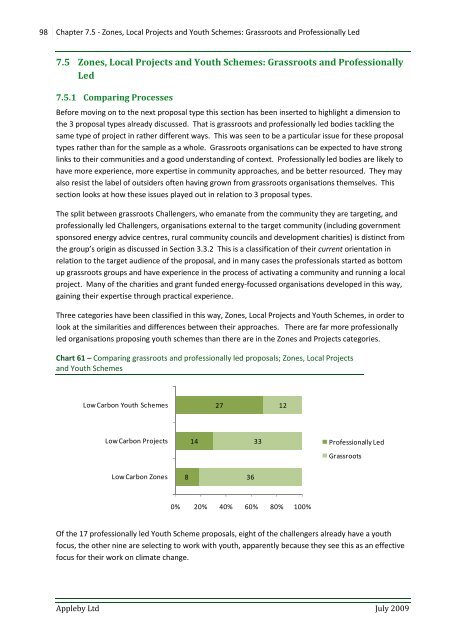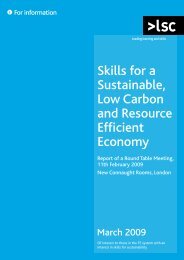Mapping the Big Green Challenge - The Skills & Learning ...
Mapping the Big Green Challenge - The Skills & Learning ...
Mapping the Big Green Challenge - The Skills & Learning ...
Create successful ePaper yourself
Turn your PDF publications into a flip-book with our unique Google optimized e-Paper software.
98 Chapter 7.5 - Zones, Local Projects and Youth Schemes: Grassroots and Professionally Led7.5 Zones, Local Projects and Youth Schemes: Grassroots and ProfessionallyLed7.5.1 Comparing ProcessesBefore moving on to <strong>the</strong> next proposal type this section has been inserted to highlight a dimension to<strong>the</strong> 3 proposal types already discussed. That is grassroots and professionally led bodies tackling <strong>the</strong>same type of project in ra<strong>the</strong>r different ways. This was seen to be a particular issue for <strong>the</strong>se proposaltypes ra<strong>the</strong>r than for <strong>the</strong> sample as a whole. Grassroots organisations can be expected to have stronglinks to <strong>the</strong>ir communities and a good understanding of context. Professionally led bodies are likely tohave more experience, more expertise in community approaches, and be better resourced. <strong>The</strong>y mayalso resist <strong>the</strong> label of outsiders often having grown from grassroots organisations <strong>the</strong>mselves. Thissection looks at how <strong>the</strong>se issues played out in relation to 3 proposal types.<strong>The</strong> split between grassroots <strong>Challenge</strong>rs, who emanate from <strong>the</strong> community <strong>the</strong>y are targeting, andprofessionally led <strong>Challenge</strong>rs, organisations external to <strong>the</strong> target community (including governmentsponsored energy advice centres, rural community councils and development charities) is distinct from<strong>the</strong> group’s origin as discussed in Section 3.3.2 This is a classification of <strong>the</strong>ir current orientation inrelation to <strong>the</strong> target audience of <strong>the</strong> proposal, and in many cases <strong>the</strong> professionals started as bottomup grassroots groups and have experience in <strong>the</strong> process of activating a community and running a localproject. Many of <strong>the</strong> charities and grant funded energy-focussed organisations developed in this way,gaining <strong>the</strong>ir expertise through practical experience.Three categories have been classified in this way, Zones, Local Projects and Youth Schemes, in order tolook at <strong>the</strong> similarities and differences between <strong>the</strong>ir approaches. <strong>The</strong>re are far more professionallyled organisations proposing youth schemes than <strong>the</strong>re are in <strong>the</strong> Zones and Projects categories.Chart 61 – Comparing grassroots and professionally led proposals; Zones, Local Projectsand Youth SchemesLow Carbon Youth Schemes2712Low Carbon Projects1433Professionally LedGrassrootsLow Carbon Zones8360% 20% 40% 60% 80% 100%Of <strong>the</strong> 17 professionally led Youth Scheme proposals, eight of <strong>the</strong> challengers already have a youthfocus, <strong>the</strong> o<strong>the</strong>r nine are selecting to work with youth, apparently because <strong>the</strong>y see this as an effectivefocus for <strong>the</strong>ir work on climate change.Appleby Ltd July 2009











